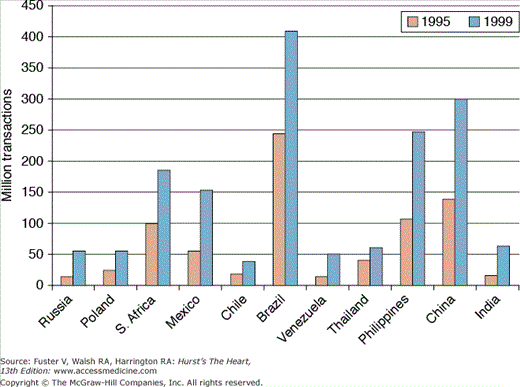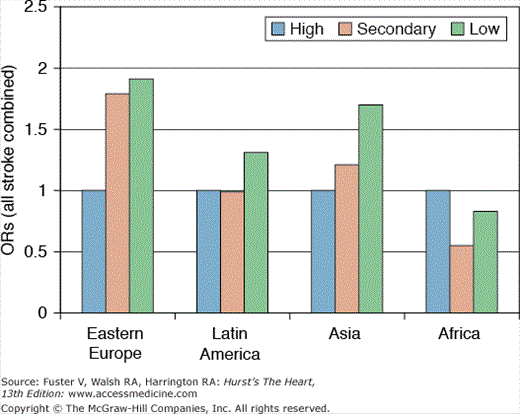Societal and Social Issues of Heart Disease: Introduction
Unlike previous chapters that have primarily focused on clinical factors and proximal determinants of heart disease, this chapter tackles the broader societal and social forces that influence this health condition at the population level. As outlined in the final report of the World Health Organization (WHO) Commission on Social Determinants of Health, “heart disease is caused not by a lack of coronary care units but by the lives people lead, which are shaped by the environments in which they live…the main action on social determinants of health must therefore come from outside the health sector.”1 The chapter is divided into three parts. First, we will analyze how societal factors influence heart disease, with particular reference to socioeconomic development and socioeconomic gradients of heart disease and related behavioral risk factors. Then, we will examine the role of social factors including social organization, social relations, and chronic stress, including work stress. Finally, we will discuss prevention strategies to reduce heart disease and the socioeconomic gradient of heart disease at the population level.
Societal Factors and Heart Disease
The influence of societal factors on heart disease is supported by at least two major categories of scientific evidence: The epidemic change in response to socioeconomic development that profoundly affected standards of living and habits; the socioeconomic gradients of heart disease and related behavioral risk factors varied according to the stage of socioeconomic development.
As underlined in the WHO report on social determinants of health, despite the existing epidemiologic differences between rich and poor countries, the causes of heart diseases are the same wherever these diseases occur. The emergence of heart diseases in both developed and developing countries is largely associated with the advent of industrialization and urbanization that improved socioeconomic conditions and changed the way of living.2,3 Evidence shows that the diffusion and decline of this health condition vary according to the stage of socioeconomic development of a country, especially in the context of the epidemiologic transition from infectious to chronic diseases. Although heart disease has often been regarded as a disease of affluent societies, the rapid socioeconomic changes that transformed patterns of consumption and lifestyle have rapidly affected developing countries, especially in the last decades. Rates of coronary heart disease are still low in the poorest regions of the world, including sub-Saharan Africa and the rural areas of South America and South Asia. But they have become more common in regions characterized by increasing wealth, longevity, and lifestyle changes in diet, exercise, and smoking, such as India and Latin America. Rates are declining in Western Europe, North America (excluding some parts of Mexico), Australia, and New Zealand as changes in the way of living delay ischemic heart disease and stroke to more advanced ages.4
Whereas the epidemic in affluent societies increased and declined over the course of a century, the transition in the developing world has been compressed into a few decades.5 More recently, this process of rapid diffusion of heart disease has been exacerbated by the “Westernization” of lifestyle and economic globalization that produced further changes in terms of urbanization, agricultural production, and food consumption.6 One of the effects of globalization is what has been called the coca-colonization of living habits including increased consumption of fats and sweeteners.7 As countries are more progressively integrated in the world economy, they converge to more homogeneous patterns of lifestyle and consumption, leading to similar chronic diseases. Different studies8,9 have shown that trade liberalization policies and the removal of barriers to entry for transnational food companies have promoted poor-quality diets characterized by energy-dense, nutrient-empty foods worldwide. Indeed, as shown in Fig. 116–1, the number of transactions at chained burger and chicken outlets in transitional and developing economies increased dramatically between 1995 and 1999.
Figure 116–1.
Fast food consumption (number of transactions at chained burger and chicken outlets) in selected countries in 1995 and 1999. From Hawkes C. Marketing activities of global soft drink and fast food companies in emerging markets: a review. In: Globalization, Diets and Non-communicable Diseases. Geneva, Switzerland: World Health Organization; 2002.
The globalization of lifestyle patterns has been particularly strong among younger generations,10 with the United States leading the change11 and child obesity becoming more prevalent in less developed societies.12 Trade liberalization policies have also indirectly promoted tobacco smoking in developing countries. A World Bank study found that reduced tariffs in some parts of Asia resulted in a 10% increase in smoking rates above what they would have been without trade liberalization. Increases within certain population groups, such as teenage males (18.4%-29.8% in 1 year) and teenage females (1.6%-8.7%) in Republic of Korea, were even starker.13
The importance of societal factors in influencing heart disease is also manifested by patterns of change of socioeconomic inequalities in the distribution of this health outcome and its related behavioral risk factors. Evidence shows that inequalities in heart disease change according to the stage of epidemiologic transition reached by a country. People in higher socioeconomic positions are usually the first to be affected by the disease and related behaviors in the earlier stages of the transition, but then they are also the first to experience a decline of both the condition and risk factors in later stages of the transition. Indeed, in the most advanced economies, such conditions become progressively more prevalent among lower socioeconomic groups, with socioeconomic gradients of heart disease and risk factors that reverse over time.
The epidemiologic transition of heart disease from being a disease of the wealthy to one of the poor has been analyzed in the changes in the socioeconomic distribution of heart disease in developing and developed societies. Figure 116–2 shows the unadjusted odds ratios for stroke (whose epidemiologic transition preceded that of heart disease) in different regions of the world and their association with secondary and low educational strata using high education as the reference group. An inverse association with education was found in Asia, Latin America, and Eastern Europe, with the effect most pronounced in Eastern Europe and least apparent in Latin America. On the contrary, the association appeared to be positive in Africa.14
Figure 116–2.
Unadjusted odds ratios (ORs) for all stroke combined by educational level (high, secondary, and low) in four regions. Data from Chang C, Marmot M, Farley T, et al. The influence of economic development on the association between education and the risk of acute myocardial infarction and stroke. J Clin Epidemiol. 2002;55:741-747.
In developing societies, the heart disease epidemic struck the more affluent sections of society first, but as the epidemic matured, the socioeconomic gradient reversed, with socioeconomically disadvantaged groups becoming increasingly vulnerable.15 Higher risks for coronary heart diseases among advantaged groups have not only been reported in Africa, but also in Hong Kong,16 Puerto Rico,17 and Pakistan.18 In the most affluent nations and former socialist countries, there has been a reversal in the association between coronary heart disease mortality and socioeconomic position observed during the 20th century, with widening mortality gap over time. The socioepidemiologic “cross-over” has been documented in England and Wales,19 where there has been a greater decline in coronary heart disease mortality among higher socioeconomic groups during the latter part of the century, which has increased inequalities over time.20
As countries “develop,” they converge to a more homogeneous social pattern as low socioeconomic position progressively becomes a systematic risk factor for coronary heart disease both in developed and developing societies.
The epidemiologic transition of heart disease across socioeconomic groups coincides with the transition of conventional coronary heart disease risk factors including health behaviors. The most affluent social groups are the first to change their lifestyle and consumption habits that lead to the development of risk factors such as obesity, physical inactivity, smoking, high blood pressure, and high cholesterol levels. However, as these changes influence society as a whole, behavioral risk factors for heart disease become more common among less privileged socioeconomic groups both in affluent and less affluent societies.





